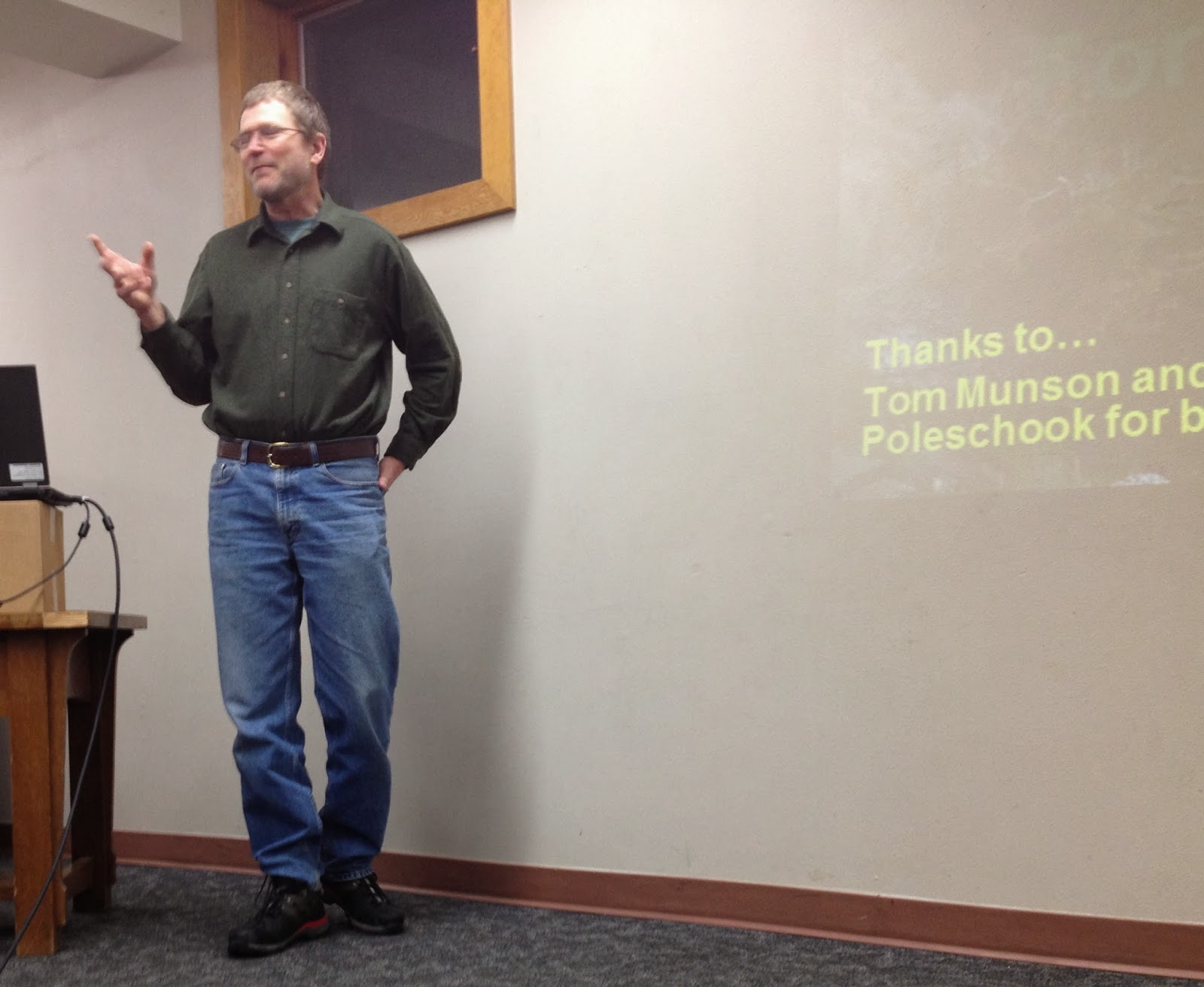Donna and I went to a public talk at the library here in town given by a local biologist Chris Logger.
Before I get to the talk, I have a amusing story of my own. I was headed across town to check up on the motorhome, which is parked very near the Little Pend Oreille Wildlife Refuge, when out of the corner of my eye I noticed a Red-Tail hawk skimming the brush and suddenly swopped to the ground. I parked and shot a few pictures as he flew away to a fence post and didn't think about it again until I uploaded the photos on our PC. I took ten or more photos and was so focused on the hawk that I never even noticed the deer in the background until I got home.
It is hard to see, unless the previous photo is magnified, the hawk had a mouse or vole in his beak while flying. Here the hawk is on a fence post...having lunch. Bon Appétit :-)
I always take the loop around the wildlife refuge in hopes of seeing a moose or wolf but only saw many groups of white tails.
This pretty girl caught my eye while she was resting on the snow. I'll assume most females are long impregnated and it won't be but a few months before we start seeing some fawns.
In all honesty I was thinking this might be a discussion about traveling in our part of America...not so much.
The "forgotten corner" refers to the circled area which encompasses all of the Colville National Forest and the three mountain ranges within in it, the Okanogan, Kettle River and Selkirk mountains. The forgotten part is partly because the ranges only rise to approximately 7000 feet and we are stuck in the farthest northeast corner of the state. Besides the mountain ranges there are also many great rivers that include the Columbia, Pend Oreille, Kettle and the Okanogan all of which run through glacier carved valleys.
Chris Logger is a long time Colville resident who has initiated many studies involving animal behavior, forest animal counts and their habitats . As a bonus his wife is also a biologist
in plant life of the area.
Donna enjoyed the discussion especially when the talk turned towards birds of prey.
This is Chris's way of telling us he is not the Paul Bunyan of the forest despite his last name.
Most all the photos were shot with my phone from slides that were projected on the wall so the quality may be slightly lacking...this is done in order not to annoy any of the other listeners.
Chris lectured that at the moment the forgotten corner is the only place in the lower 48 states that still have as residents the same large mammals that were here at the time of the Pilgrims landing.
I'll assume buffalos were not living in the area at that time.
While it may look like the wolverine is trapped or stuck on the tree stand he wasn't. The wolverine is hard to study as they roam large tracks of land from the Arctic through Canada and the top of the lower 48 states and although they (biologists) have proof he passes over the Colville Forest they have no proof he resides here. He was captured on film by a "game camera" set up over looking some meat hung in the tree.
I love this description by Doug Chadwick:
"If wolverines have a strategy it's this: Go hard, and high and steep and never back down. Not even from the biggest grizzly and least of all from the mountain. Climb everything.... Eat everybody. Alive, dead, long dead, moose, mouse, fox, frog, it's still warm heart or frozen bones.
You can in the years following the ban on DDT this area boasted three nests of the bald eagles.
Just 15 years later you can see what a tremendous success banning DDT and protecting the bald eagle with the Endangered Species Act of 1973 has had on the amount of nests in our area...but this does come at a cost.
Loon chicks are a favorite of the eagles as are the great heron babies. Osprey have also been pushed out of our valley by the sheer number of eagles that live and nest here. One of the biggest problem with the loons are that people regard them as ducks which of course they are not. Ducks can reach sexual maturity within the first year and have many chicks per birth but loons do not generally have their first clutch of (two eggs) until they are 7 years old. Long lived but an extremely lengthy time to sexual maturity along with an ever increasing eagle population doesn't bode well for these beautiful birds.
Seems like every time we humans attempt to control nature it bites us in the butt.
Our talk included flora and insects such as this "white-butt bumblebee" which Chris asked us to keep a sharp eye out for in our yards. This benifcal insect pollinates many of the fruits and flowers that our gardens need. The newspaper article from last years Seattle paper will tell you how rare the white butts have become.
About the title of this blog. Yesterday we got 3 1/2 inches of snow on top of the 8 inches already on the ground. This morning I woke to 38 degree temps (I have a weather station in the yard) and it rose to an unbelievable 49 degrees. By listening to the roof gutters you'd think it was raining, the snow was melting that fast.
Well, off to get the deer some more alfalfa.














No comments:
Post a Comment